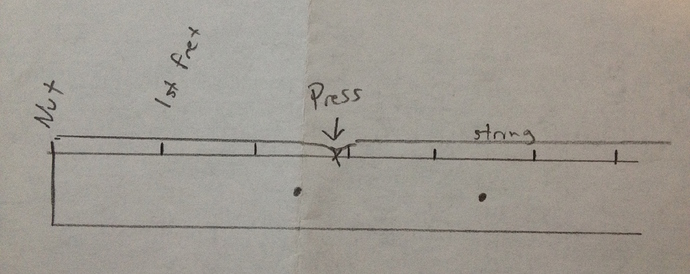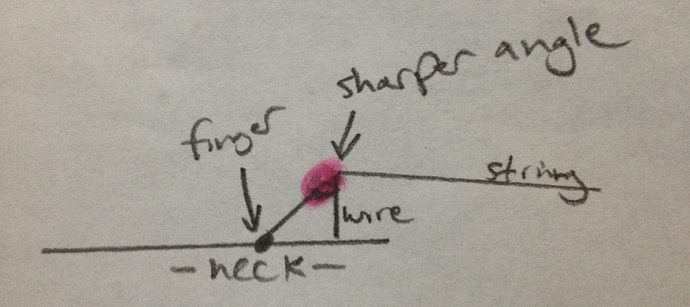I’ve seen bassists who press right on the metal fret, some slightly off it and some centre between the metal bits. Is there an optimal place to press or doesn’t it matter?
I’ve noticed that too! Could it be a setup thing?
I used to think the same thing. I finally learned that you press as close as you can behind the fret.
Ooh, I have such a boring physics-y answer for this! I think I address this in our Bass Basics videos, but you’re aiming for somewhere between the middle of the fret to right behind the fret wire, in general.
Nerdy part - the closer to the fret wire your finger presses, the less pressure you need to make solid contact because there’s a steeper angle of contact from string to fret wire. So there’s some flexibility of exactly where you press down, but if you go too far away from the wire, it starts to become very likely that you’ll get nasty buzzing/rattling sounds.
Does that make sense? If anyone is confused I will draw a hideous sketch to illustrate.
SKETCH! SKETCH! SKETCH! SKETCH!!
Please?
That makes sense, Josh. Thanks. But yeah, show us your drawing chops 
Okay, the much begged for sketches, @Gio and @Chris eat your hearts out.
So the closer you press to the fret wire at the end of the fret (meaning the side of the fret closer to the pickups), the sharper angle you’ll get against the fret and the less pressure you’ll need to apply to sound good. Here’s a close up of if you press far away:
And if you press closer -
This is where my so-called “physics” knowledge has a gap - I don’t know exactly why that sharper angle reduces the amount of force needed to keep the string in good contact with the fret wire - anybody smarter than me have an explanation for that?
But anyway, it works, and you can test it for yourself by fretting a note, and then gradually slide your finger the “wrong” way until it makes an awful rattly noise. Congratulations, you can now sound like this guy!!!
Sounded ok to me! 
You saw it here first guys! The birth of a new illustrating master! Someone record this for posterity.
That’s helpful J man. I’ve watched what some do and the best sounding players seem to do it as you instruct us. I’ve seen some people push directly on the fret bar which seems like it could cause some issues.
I loved it! The bass face was a little frightening.
Well the thing is that your finger is a mushy creature, so the spot where pressure is most directly applied is in the middle of your finger where the bone is. So it’s possible to press right behind the wire with the middle of your finger, and have some of the rest of your finger overlap with the fret wire, so it looks like you’re “pressing on the wire” but you actually aren’t, exactly.
BUT some people probably do press right on the wire, and they’re asking for trouble. ![]()
Haha, yeah, that’s not my real bass face, this is some of my high-level character acting.
Nice sketches. And thanks for giving the people what they wanted.
Phew… waiting for my bass, (can’t!) so trying to keep the cool browsing the forum, don’t want to start the lessons without the bass…
I’m a technical trainer and know the importance of learning it right at the first time, bad habits are really difficult to fight against afterwards… thanks for the post! Made me understand this technique detail, and that means I won’t forget it and will be “on top of it” since the very beggining!
I don’t know exactly why that sharper angle reduces the amount of force needed to keep the string in good contact with the fret wire - anybody smarter than me have an explanation for that?
While I disagree on the “smarter than you” part ![]() , the other one I think could be due to lever effect in a composed way with forces action/reaction.
, the other one I think could be due to lever effect in a composed way with forces action/reaction.
Here’s how I see it: string is tied at nut point, once you pluck it and starts vibrating, the closer the pressure point is to the fret, the steeper the angle the string forms vs the fret wire, and hence the more pressure it applies back against the string (reaction) aiding you to stop remaining string vibration more efficiently.
In hydraulics, for two given surfaces in contact, the smaller surface always exerts a higher pressure against the other, that’s why needles pierce our skin easily, thanks to the honing, i.e. achieving a pointy, the smallest surface possible. Try the same with a paper clip, you’ll need much more force to pierce the skin as the pressure exerted from the rounder paper clip wire end will be lower.
The fret wire is the sharp edge (needle analogy) that aids on exerting less force, the closer you are to it, the more effectively it ties the string to the fretboard as it “gives back” more pressure on the string, and the more the fret aids, the less applied pressure is required from you.
As you move farther away from the fret, the less pressure it exerts back to the string, leaving both used and “unused” string portions working as levers, fighting against you stopping it, and possibly introducing the spurious sounds (rattle) as both string portions vibrate fighting against each other.
I think that makes sense! We’ll see when my head stops spinning and the dust settles. 

Hahaha
Lol I’ve done this ! Hahaha
Sooo funny ! This guy need to show up in more stuff! Lol
Haha maybe he does, it’s been years since he made a public appearance…
Hmmm . . . I just know I’ve seen that guy somewhere before . . .
It’s killing me. 


